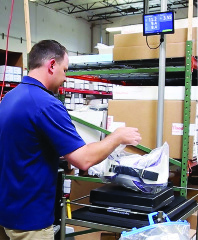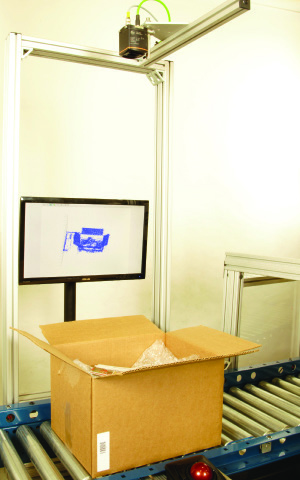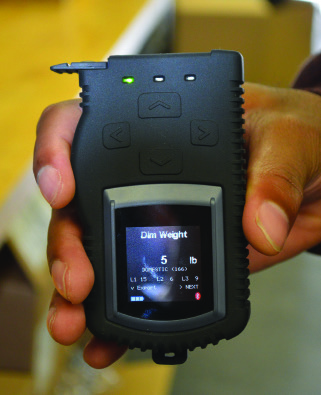Cubing and Weighing Equipment: Measure Up
The use of cubing and weighing equipment is growing beyond dimensional weight applications.
Cubing and weighing equipment, otherwise known as dimensioning systems, is expanding in use throughout warehousing and distribution operations. When major parcel carriers like FedEx and UPS switched to shipping fee calculations based on both package weight and size, or dimensional weight (DIM weight), in early 2015, interest in—and installation of—automated systems to more accurately capture item data increased, particularly with the spectacular growth of e-commerce shopping and parcel shipping.
However, as more operations have installed this equipment, they’ve discovered additional benefits beyond the initial objective of reducing shipping charges. Instead, these technologies are also now being used to increase storage density within manual and automated storage and retrieval systems (AS/RS), direct pack out (including secondary packaging selection and on-demand carton construction), and automate quality control.
Further, the equipment itself has continued to evolve. Today’s dimensioning technologies are outfitted with mobility, camera-based imaging and sophisticated algorithms that measure irregular shapes and detect anomalies.
Dimensioning on the go
While most operations have a dimensioner at outbound shipping, many facilities now recognize the advantages of having a separate system at receiving, says Justin Headley, marketing manager at CubiScan.
“Anywhere cubic data is collected, an automated dimensioning system replaces it to streamline data capture for optimization of warehouse space, to identify best packaging solutions and decrease shipping charges,” Headley explains.
Without a dimensioning system, warehouse employees must input information provided by the manufacturer or manually measure to determine each stock keeping unit’s (SKU) length, width and height. They then enter the cubic data into software such as a warehouse management system (WMS), enterprise resource planning (ERP) system, or a shipping or transportation management system (TMS) platform.
That method, however, is time consuming, error prone and doesn’t account for irregularly shaped items. Therefore, more companies are investing in automated dimensioners to collect accurate size and weight information for products as small as a contact lens up to a large piece of furniture. Beyond selecting more accurately sized secondary packaging, the dimensions are used by the WMS for dense slotting of inventory within storage for better use of space.
 The latest dimensioners are portable, allowing them to be used anywhere, adds Headley. They also are equipped with technologies that allow them to assess the volumetric size of an irregular object, from polybagged apparel to nuts and bolts to fire hydrants and furniture.
The latest dimensioners are portable, allowing them to be used anywhere, adds Headley. They also are equipped with technologies that allow them to assess the volumetric size of an irregular object, from polybagged apparel to nuts and bolts to fire hydrants and furniture.
“The CubiScan 325 deploys infrared sensing technology paired with four load cells to capture larger, non-uniform objects’ dimensions and weight,” Headley notes. “It’s accurate up to 0.05-inch and 0.005 pounds and handles items from 0.1 x 0.1 x 0.1 inches to 36 x 24 x 24 inches and weighing from 0.005 to 50 pounds.”
Having a mobile dimensioner lets an operator to walk up and down every aisle capturing cube data for all SKUs. “Then it can be parked in the receiving dock to measure new items moving forward so the master file always has current cube and weight data,” Headley adds.
Dimensioner mobility is increasingly important, with a particular uptick in interest among small and medium-sized e-commerce operations as the technologies become more affordable and agile, says Paula Heikell, vice president of product marketing at Logistyx Technologies.
“Previously there were a lot of table-based dimensioning products that were fixed in one location,” Heikell recalls. “Items had to be brought over and carefully lined up for the measurement to be accurate. With the way e-commerce is impacting retail sales, we have a lot customers who are growing quickly and want a mobile system that they can use wherever they need it.”
For a Logistyx customer that is an online retailer of home goods, including large items such as swing sets and sofas, the ideal solution has been a handheld dimensioning system called Size-IT, Heikell adds. “A standard cubing system wasn’t going to work for them. Instead, they have more than 100 associates equipped with these handheld devices that they use to measure items wherever they are,” she explains.
Faster, more accurate sensors
Improvements in speed and accuracy, combined with dropping costs, have made 3D camera-based imaging and sensing systems ideal for dimensioning applications, explains Dan Hanrahan, president of The Numina Group.
“3D imager response time is dramatically faster, and the resolution is 10 times higher than just a few years ago; it now takes just a few milliseconds to capture multiple images and produce an accurate length, width and height measurement,” Hanrahan explains. “Their performance has improved tremendously for accurately measuring items very quickly in an in-line conveyor application, for example.”
Likewise, the latest weigh indicators—the digital instruments that capture the data from the weigh sensors—also feature increased processing speed.
 “There’s been an increase of almost ten-fold in the last five years in terms of performance,” Hanrahan continues. “The time that the parcel spends on top of the scale has been reduced to less than 100 milliseconds. In a high-volume distribution center that equates to one second of time saved every 10 parcels. That translates into as much as three more cartons processed per minute in applications that require in-line scan/weigh-dimensioning and parcel manifesting print-and-apply labeling applications.”
“There’s been an increase of almost ten-fold in the last five years in terms of performance,” Hanrahan continues. “The time that the parcel spends on top of the scale has been reduced to less than 100 milliseconds. In a high-volume distribution center that equates to one second of time saved every 10 parcels. That translates into as much as three more cartons processed per minute in applications that require in-line scan/weigh-dimensioning and parcel manifesting print-and-apply labeling applications.”
The data captured by these sensors enables the warehouse control system (WCS) or warehouse execution system (WES) to automatically capture the dimensions of the package, whether that’s an envelope, padded bag or carton, then interface with the WMS to optimize on-demand secondary packaging systems. “The data can be used to determine the smallest dimensional envelope classification for the U.S. Postal Service, for example, saving up to 75 cents per package,” Hanrahan adds.
Add-ons enhance quality control
One of the latest trends in dimensioning system installations is the addition of cameras that capture digital images to document the contents of a package before any void fill is added prior to parcel sealing.
“Digital cameras with Ethernet communication add the ability to add image-based validation to shipping systems,” notes Hanrahan. “Companies can now capture and store a digital image for customer service to show that the right items were picked and packed in the carton before it left the facility. Digital image capture can also be used to verify the correct labeling for compliance purposes.”
For order quality control, the packed carton’s actual weight can be compared to its anticipated weight based on the picked items known dimensional weight information. “If the numbers don’t match, the parcel is automatically routed to the inspection audit station for an operator to open, inspect and determine any discrepancy,” Hanrahan adds.
Big Data-backed dimensioners
Palletload handlers, such as LTL shippers, are also benefitting from the faster speeds and larger volume handling capacities of the latest dimensioning systems and from the data they capture. Adding intelligence to that data, says Michael Murphy, founder and CEO of QubeVu, is the next step.
“Our more sophisticated customers are not only concerned with dimensioning as a means to gather volumetric and weight information, but how can they use that information to support compliance, loss mitigation, process optimization and safety,” Murphy says.
“When we scan and assess an item, we think of it in terms of compliance with the 10,000 or so rules that apply in any one location. Not just in terms of loss mitigation and who pays for damage, but also process optimization and safety,” Murphy adds. “Scanning with a mechanical, wavy laser device certainly gets your dimensions, but what it doesn’t get you is enough information so that you can take a Big Data approach. That’s the next step in dimensioning.”
QubeVu’s system uses camera-based imaging to determine the volumetric size of a palletload, both cuboid and irregularly shaped items up to 8 x 8 feet. What makes the system different is the Cloud-based image storage and analysis, built on sophisticated algorithms that identify and score anomalies and alert an operator to intervene.
“Our system can detect if a corner is crushed, or if something appears to be leaking, or if there is agricultural debris on a pallet that’s being transported from Florida to Georgia and needs sterilization first, for example,” says Murphy. “The technology behind the dimensioning system takes into account international and domestic rules and norms to flag potential problems and prevent fines.”
The same system, Murphy adds, can identify if a box on a pallet of bleach appears to be leaking and tag it for routing to hazardous materials cleanup, rather than put it on a vehicle and potentially damage other crates.
“If the average fork truck driver sees something that might or might not be a leak, they’re probably going to let it go. But if there’s leaking bleach on a vehicle full of otherwise human consumable food, you’re potentially looking at a $500,000 write-off,” Murphy says. “Likewise, when our vision system detects that there’s a hazardous material on a pallet, it cross-references that data with its destination routing to ensure that it is not sent on a vehicle that goes through a tunnel, for example.”
Companies mentioned in this article:













